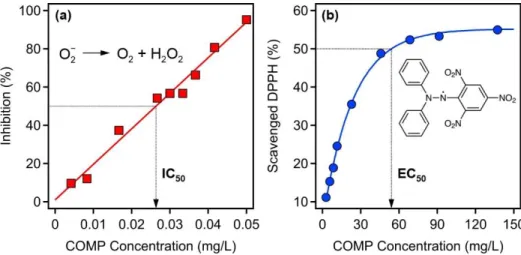Electronic Supplementary Information (ESI)
Catalytic Antioxidant Nanocomposites Based on Sequential Adsorption of Redox Active Metal Complexes and
Polyelectrolytes on Nanoclay Particles
Zoltán Somosi,
aNóra V. May,
bDániel Sebők,
cIstván Pálinkó
dand István Szilágyi*
aaMTA-SZTE Lendület Biocolloids Research Group, Interdisciplinary Research Center,
Department of Physical Chemistry and Materials Science, University of Szeged, H-6720 Szeged, Hungary
bResearch Centre for Natural Sciences, Hungarian Academy of Sciences, H-1117 Budapest, Hungary
cDepartment of Applied and Environmental Chemistry, University of Szeged, H-6720 Szeged, Hungary
dDepartment of Organic Chemistry, University of Szeged, H-6720 Szeged, Hungary
*Corresponding author. Email: szistvan@chem.u-szeged.hu Electronic Supplementary Material (ESI) for Dalton Transactions.
This journal is © The Royal Society of Chemistry 2021
Table S1. Sample preparation methods for EPR measurements.a Sample Preparation method
Cu(Bpy)2 in solution 1.5 mM of CuCl2 and 3 mM of Bpy mixed in water (pH ~ 7) Fe(Cit)2 1.5 mM of FeCl3 and 3 mM of sodium Cit mixed in water (pH
was set to 8 for 1:2 complex formation) Cu(Bpy)2 and Fe(Cit)2
together in aqueous solution
0.5 mL of 15 mM Cu(Bpy)2 and 0.5 ml of 15 mM Fe(Cit)2 was added into 4 mL of water
100ppm COMP 50 μL of 10000 ppm LDH solution was added into 2884 μL water, 1000 μL of 5×10-5 g/L PSS solution was added 2 h later, 33 μL of 15 mM Cu(Bpy)2 was added after 4 h, 1000 μL of 5×10-5 g/L PDADMAC solution was added after 6 h and 33 μL of 15 mM Fe(Cit)2 was added after 8 h
400ppm COMP 200 μL of 10000 ppm LDH solution was added into 4453 μL water, 40 μL of 5×10-3 g/L PSS solution was added 2 h later, 133 μL of 15 mM Cu(Bpy)2 was added after 4 h, 40 μL of 5×10-
3 g/L PDADMAC solution was added after 6 h and 133 μL of 15 mM Fe(Cit)2 was added after 8 h
100ppm LDH-PSS-Cu(Bpy)2 50 μL of 10000 ppm LDH solution was added into 3916 μL water, 1000 μL of 5×10-5 g/L PSS solution was added 2 h later, 33 μL of 15 mM Cu(Bpy)2 was added after 4 h
400ppm LDH-PSS-Cu(Bpy)2 100 μL of 10000 ppm LDH solution was added into 4726 μL water, 40 μL of 5×10-3 g/L PSS solution was added 2 h later, 133 μL of 15 mM Cu(Bpy)2 was added after 4 h
aFinal volumes for all samples were 5 mL at preparation.
Fig. S1 XRD diffractogram (a) and IR spectrum (b) of the LDH material used as carrier in COMP.
2600 2800 3000 3200 3400 3600 Magnetic field (G)
(a)
(b)
(c)
24% D 76% E
30% A 70% C
Fig. S2 Measured (black) and simulated (red) EPR spectra of samples containing (a) 400 ppm COMP, (b) 400ppm LDH-PSS-Cu(Bpy)2 and (c) Fe(Cit)2 in aqueous solution. For details of sample preparation see Table S1 and the component spectra are shown in Figure 3.
Fig S3. Superoxide (a) and DPPH (b) radical scavenging ability of the COMP hybrid. The concentrations necessary to decompose 50% of the radicals (IC50 (a) and EC50 (b)) are indicated.
The solid lines are mathematical functions used to calculate the IC50 and EC50 values. The dismutation scheme for superoxide radicals and the chemical structure of DPPH are shown in the insets in (a) and (b), respectively.


